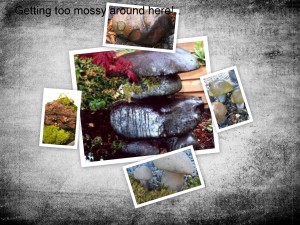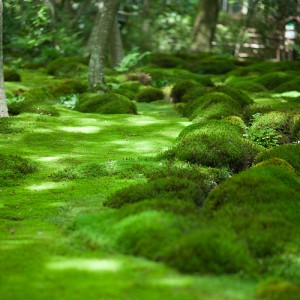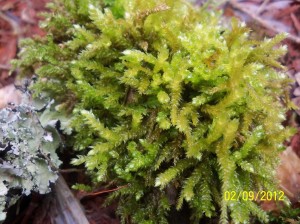Some of the basic ingredients to growing it are:
1.“Using sterile soil”and remembering that moss likes humidity, coolness, shade or indirect sun. The mix is for you to experiment with. This is the standard Nursery mantra. Mycorhiza lacking soil usually is the normal basis for nursery potting mix. I just experimented sowing mosses and tried out 6 different soil mixes including decayed log debris, pine needles, loam, compost and the normal sphagnum soil mixes.
2. Surprisingly good drainage is a must and bottom holed plastic pots are verboten. Side draining holes are preferable as are clay pots. (sterile!)
3. keep the moss humid by misting daily for 2 to 3 weeks.
4. Most city water contains metallic oxides much less chlorine or floride. This is the kiss of death to successful moss sowing, much less growing. Distilled or rain water is preferable. In my own case my well water tests out beautifully.
5. In established planters (bonsai) this also applies in the choice of fertilizers one uses.
6 One trick given in the eBay purchase of these spores is the use of strained (Miletta filter) rice water when sowing or doing the first misting.
More representative for mosses are the two I ordered on eBay. These can be well used in in any shade landscape planting. Once again, I will be experimenting with different soil mixes, including my Sarracenia mix which is sphagnum, builders sand and pumice. From there I will try some that will include loam and or broken down decomposing forest wood material. The pictures are credited to the above angellittletreasures.
On fertilizer and soils:
Sphagnum Peat Moss, sharp gravel, perlite and (pine or fir bark when needed) are prime ingredients in my soil mixes for different plants. Be it for Sarracenia or Bonsai one adapts the material to the need. The above mix has shown to be very good for the few larger bonsai I used to have.
Peat mosses:
The Sphagnum Peat Moss available in Northern Europe or of New Zealand is of a very high quality It has a very beneficial influence on the root development as well as buffering abuses of fertilizer.
It also precipitates nutrients well, releasing these slowly. This is an important feature of any soil.
The structure is broken down over time, but when dealing with bonsai, it works well for three or four years. Mixed with sharp gravel or perlite it will last up to four to five years before being broken down too much. The best quality to look for is a light color and reasonable roughness, making it last longer before broken down, securing oxygen in the soil.
The PH value (acidity) of the soil differs according to the type of Sphagnum but this can be regulated by adding lime or acid materials to the soil.
Pine bark:
Adding Pine bark to the soil mixture is beneficial for especially pines, but also a few other specimens benefits from this. The pine bark has the main purpose of having a good influence on the development of Mycorhiza a symbiotic fungi attached to the roots of the pine, seen as some white fluffy thread attached around the roots. The Mycorhiza helps the pine taking up nutrients and water, and the tree delivers nutrients back to the fungi. All in beautiful symbiotic dependence.
It is a theory that many other plants also have this symbiotic relationship between roots and fungus. Pine bark or Fir bark also takes up nutrients to a certain extend, but much less than Sphagnum Peat Mosses.
Akadama, is a Japanese clay product that I rarely use, also has the ability of precipitating nutrients. I do not know of how well this works for that type of soil, but it probably works good based on the structure of the gravel. It is also used in water gardening.
Gravel:
Gravel has two main purposes. To secure drainage in the bottom of the pot, and to add drainage to the soil mix.
Depending on the physiological structure of the gravel, it may or may not be able to precipitate nutrients, and release these in a shorter or longer time span.
Most gravel has a lifetime unbreakable structure, others wither with time.
Using pure gravel or anything with the structure as gravel will not be able to bind any nutrients. This means that any nutrients will be washed out immediately, and nothing will be stored for later use, when watering without adding nutrients to the water on a regular basis.
For trees that do not need much feeding that might work well on a shorter time span. But the health of the tree and the vigor and growth will be set back over time, because lack of the main nutrients and micro and macro-nutrients will influence on the ability to develop healthy roots, back budding, flowering i.e.
Re potting a tree into pure gravel has only one purpose. Saving a tree with rotted or otherwise harmed roots, by adding as much oxygen to the roots as possible using pure gravel, but on a short time span.
Afterward, when the tree has reestablished the root system, it is necessary to use a soil mixture with the ability to precipitate and release nutrients.
Fertilizers and their influence on the soil:
Using soil with the ability of storing and releasing nutrients can have a side effect when using chemical fertilizers. Over feeding will have a negative effect, so be careful not to do this. Chemical fertilizers also break down the structure of the soil faster than when using organic feeding, making it necessary to re pot more often.
Storing too high concentrations of fertilizing salts will cause roots burn. Organics fertilizers are secure to use, because these will not store salts in the soil. The nutrients form organic feeding pellets are also released slowly and thereby high concentrations are avoided. One side note, many organics may also attract varmits to dig into your pot. 🙂  (c) Herb Senft 2015
(c) Herb Senft 2015




